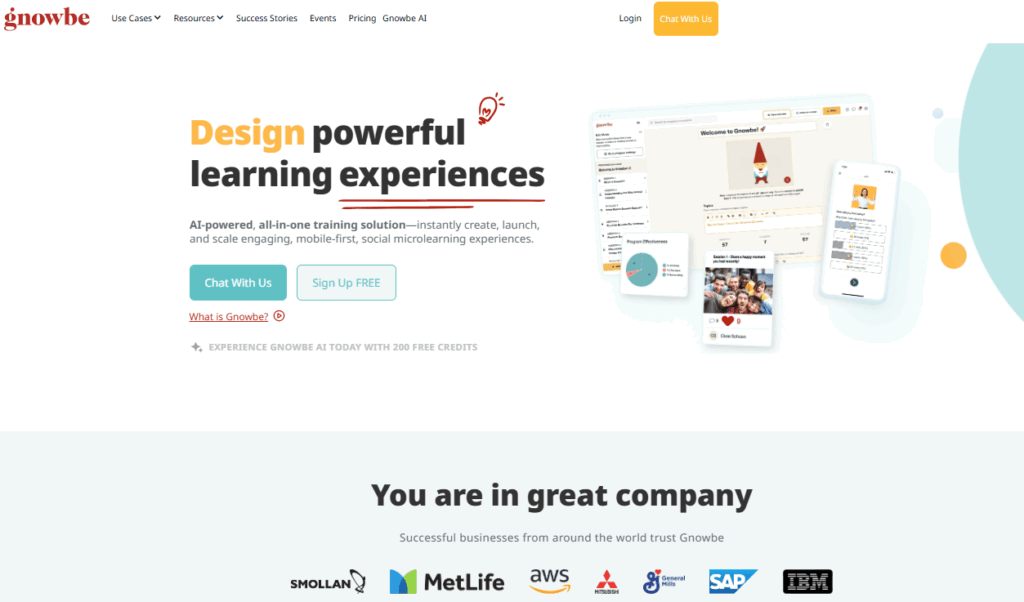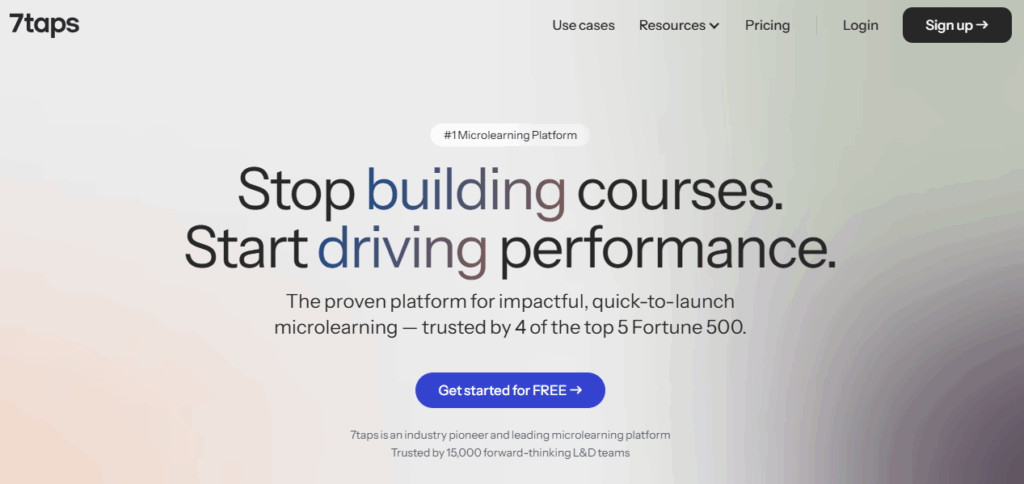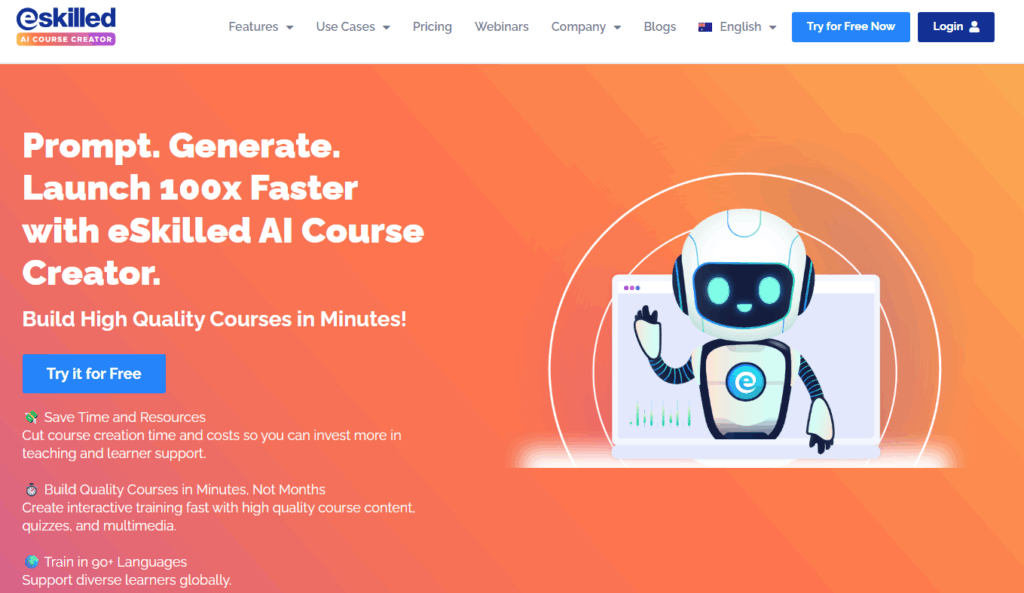Recently updated on May 20th, 2025
What is Training Development Software?
The category ‘training development software’ refers to platforms and tools that can be used to create training resources.
The vast majority of the time these resources will be digital courses e.g. self paced elearning courses, or blended course, made up of self paced and live modules.
AI features are now becoming standard in these platforms and are allowing users to create training resources in minutes, through features such as:
- Inserting interactive elements into self-paced courses such as quizzes, flashcards, videos and more.
- Generating a course outline using an AI prompt
- Converting lengthy training documents into bitesized microlearning modules.
We’ve rounded up five solutions to consider, providing an overview of the key features of each tool and the use case it’s best suited for — including why we believe Arlo, our platform, is number one.
What Should You Look for In Training Development Software?
Consider Use Case
The first point to consider is the use case.
The two main ones being:
- You’re delivering internal training, and need a tool to create employee development programs.
- You need to develop training materials for external training, for example, you’re a training provider who delivers training to clients, and creates bespoke training content for them.
Here’s an over of each:
External or Commercial Training
If you’re selling courses to clients or the public, you’ll need the tool to have the capabilities to create the training you sell.
So, for example, if you’re selling elearning you’ll need elearning authoring capabilities, if you’re selling and running live online classes, you’ll need functionality such as an integration with a video conferencing tool like Zoom.
For in-person classes you may need features that allow you to schedule and manage presenters, training resources and more, and strong ecommerce features to help you your training programs.
Internal Training
If you’re running internal training focused on employee development then you’ll need software with elearning authoring capabilities.
You have a few options here, you can look for a standalone authoring tool that integrates with a learning management system or a training management system or look for an LMS or TMS that has built in elearning authoring.
Other features you may need depending on the scope of your requirements are course libraries, learning paths, and evolving AI capabilities such as AI driven course recommendations, learner progress tracking and more.
Ease of Use for Admins and Learners
A training development platform must be easy to use for learners, content creators and admins. For commercial training providers, ease of use translates to operational efficiency.
The tool should allow you to quickly upload and convert existing training materials (think lengthy documents, PDFs) and convert them into self-paced material, have creation features that enable you to create courses from scratch or using an AI prompt.
Depending on your training requirements you may also need to look for features that enable you to run and deliver blended and in-person courses.
For internal teams, this often means enabling subject matter experts, or L&D managers who may not have instructional design backgrounds to create or update learning content quickly and deliver the right course to the right employee.
On the learner side, the platform should have a clean intuitive learner interface that works seamlessly across all devices., and a self service portal where they can access courses.
Integration & Workflow Automation
The right training development software should integrate with your other key platforms.
For training providers, this means a standalone elearning authoring tool integrating with your training management system, or using a TMS like Arlo which has elearning authoring features built in.
Other key software integrations training providers should look out for include:
- Virtual training delivery tools like Zoom or Teams
- CRMs such as Salesforce or HubSpot
- Accounting platforms like Xero
- Website and CMS integrations such as WordPress or Drupal.
For internal training teams this can mean a standalone elearning authoring tool, or a learning management system or training management system, with in-built elearning authoring features.
The same integrations apply for internal training, plus you may also want the training development software you use to integrate with your HR system.
Scalability
Training development software should scale with an org as it grows.
For a training provider you may be growing so the platform should be able to handle multiple content authors, and for internal teams this can be similar, particularly if you’re creating training for hundreds or thousands of employees.
Usually, one giveaway sign that a platform will be able to scale is the pricing model. For example, at Arlo our pricing works per license (and amount registrations you take).
The general rule is the larger a training business grows; the more licenses will be required.

If you’re looking at a stand alone elearning authoring tool pricing is determined by number of authors/licenses. For most LMSs pricing is determined by the number of learners, and number of admin licensees required.
Benefits of Training Development Software
For Commercial Training Providers (delivering training to external clients)
Content Standardization
All clients can receive the same high-quality, up-to-date content without variations across regions or trainers.
White-labeling & Branding
Most training development tools allow training companies to present the content they produce under their own brand, or customize it per client.
Scalable Delivery
Training is delivered typically through a single platform that allows the provider to serve many clients at once. More learners can be trainers can be trained without needing to hire more instructors or book more physical spaces.
For Internal Teams
Uniform Training for Employees
Training development software allows organizations to create and host their internal training programs. If a company has a lot of internal programs this may be on an LMS or TMS.
If they are delivering small chunks of training, such as bite-sized reminders or refreshers then the creation and hosting can be done through a microlearning app.
Training That Reflects the Job
Platforms give you the ability to customize courses to your own branding. And create training specifically around the role and responsibilities for a new employee.
Types of Training Development Software
Elearning Authoring Tools
Elearning authoring tools (also known as elearning authoring software) are used to build custom online training content, including interactive lessons, quizzes, videos, and SCORM or xAPI packages.
They let training providers or internal teams create their own straining from scratch, with templates, with AI generative technology, or converting an existing training resource such as a PDF into an elearning course.
Microlearning Platforms
Microlearning platforms are designed to deliver, short focused training bursts. They are well suited for frontline training, where regular refreshers are needed.
Microlearning training content is typically delivered on mobile devices, and is easy to access on the job.
All in One Training Platforms (TMS & LMS)
All in one training platforms are either training management systems or learning management systems. Training management systems are built for commercial training providers who need to create and deliver training programs externally to clients.
They can also be used for internal training, particularly if the internal training, particularly if a companies internal training involves instructor-led elements. A platform like Arlo as you’ll see has built-in elearning authoring capabilities.
Learning Management Systems are more commonly used for internal training. Depending on the platform, they may have built in elearning authoring features.
They also have more specific features for internal training such as the ability to create personalized learning paths, and reporting features around where learners are in a particular course, the courses they have completed, and their progress along a set learning path, often determined by role.
The 5 Best Training Development Software
Now you know some of the factors to look out for, let’s take a look at 5 of the top solutions 👇
1. Arlo
Arlo is a training platform with training development features for the creation, delivery, and selling of training across all formats: elearning, live online, in-person, and blended training.
Here are the key things you need to know:
When you jump into Arlo you have three options for creating self paced elearning training;
- Start a course from scratch
- Convert a document to a course
- Generate a course from AI
Starting from Scratch
Selecting this option brings you to a course builder interface where you can then title the course, and begin adding screens.
Convert a Document to a Course
This option involves converting an existing training resource you have into interactive microlearning segments.
The feature doesn’t convert your document word-for-word, but aims to make the content digestible to learners. Supported formats include Word Documents, PDFs, and Power Points.
You can either drag and drop a file here, or click on the container to upload a file from your desktop.
Creating a Course with AI
The third option involves putting a prompt into Arlo’s ‘Generate a Course’ interface.
In the video below, I’ve asked the tool to create a course for a fictional new employee ‘Steven Jones’, that welcomes him to the fictional company ‘Epic Training’. And runs him through the onboarding tasks he’ll be completing on this first day.
For converting a document to course, or generating a course with AI you can then edit the style tone, and theme of your course.
After, that you can add different interactive elements including: Images, Videos, Slideshows, Accordions, Step by Step Carousels, Flashcards, Checklists, Hotspots and Quizzes.
The End Result: An Engaging Self-Paced Course
The end result of this is an engaging self-paced course, packed full of engaging interactive features that your learners will love.
Other key training and elearning development features you can enjoy with Arlo:
Reusable Course Templates
Save time by reusing course structures for frequently delivered training. Templates can be saved, cloned, and adapted quickly, helping to maintain consistency across your course catalog, and speed up course set up and scheduling time for admins.
Blended Learning Support
Easily combine self-paced elearning with live sessions (online or in-person). Arlo manages session scheduling, communications, and registrations in one place, improving the learner experience, and simplifying your admin workload.
Trainer and Resource Management
Assign trainers to specific sessions, manage their availability, and allocate venues, rooms and physical resources.
Assessment and Certification
Create quizzes and assessments directly within the course builder. You can configure quizzes for learners to take, and set up certificates to send upon course completion.
Arlo also integrates with leading survey platforms like SurveyMonkey so you can send pre or post course surveys to gauge learner feedback.
Advanced Course Scheduling
Plan recurring sessions multi-day courses, and complex training programs with ease. Arlo’s training and course scheduling features handle timezone management, date conflicts, instructor conflicts and more.
Ecommerce and Payment Gateways
Arlo supports multiple payment gateways including Stripe, PayPal, Google Pay, Apple Pay, AfterPay (Clearpay in the UK), and Klarna – so learners can split their payments if they need to.
Ecommerce features include:
- Customizable course registration tools such as forms with support for multi-registraint, multi-course orders, screening rules, discounts, and merchandise.
- Integrated payments and invoicing via the payment gateways listed above and more, options for partial payments, vouchers.
- Accounting sync including Xero and Quickbooks
- Self-service portal for learners to manage cancellations, transfers, and access to course materials.
Best for – Commercial Training Providers
Pricing
Arlo starts at $105 USD per month
Start developing and delivering better training with Arlo. Start a free 14-day trial today.
2. Gnow Be
Gnow Be is a microlearning platform designed to help internal trams create and deploy training programs that are engaging, scalable and impactful.

The platform puts a strong focus on interactive learning, social collaboration, and mobile accessibility, and integrates will into existing training workflows.
Gnow Be’s core features combine AI course generation, gamification, peer feedback and real-time collaboration and more.
The tools ‘Magic Creator’, feature is arguably the standout part of the platform. Trainers can upload existing materials, and transform them into digestible microlearning modules.
The platform is more tailored to internal training, and acts as a good complement to larger LMS, or TMS that a business may have as its central platform for scheduling, and delivering courses.
Key Features
Interactive Microlearning – Create engaging, bite-sized training with quizzes, polls, and group activities using an easy, template-based interface.
Social & Collaborative Learning – Features for real time discussions, peer feedback, and shared learning to help with retention and team engagement.
Centralized Management: Track progress, identify gaps, and manage all training content nad users from a single dashboard.
Quick Setup & Secure Delivery: Launch training in minutes without coding, with built-in data security and integration with your other key platforms.
Best For
Internal Training,
Pricing
Paid plans for Gnowbe start at $83.70/month.
3. 7taps
7Taps is a browser based microlearning platform designed to let internal training teams create and deliver training in short interactive bursts that learners can access instantly, on any device.

Training is built using a card-based format that mirrors how people consume digital content (think stories or reels), and each lesson is designed to take just a few minutes to complete.
Users can collaborate, stats can be viewed through analytics dashboards, and training modules can be delivered via links, QR codes or workplace tools like Slack and Teams – no apps or logins required.
Key Features
Mobile-First Microlearning Builder: The tool uses a card-based authoring interface that mimics social media story formats, short tappable screens optimized for mobile. Each card contains a single learning unit, and are displayed sequentially.
AI-Powered Content Creation: 7Tap includes two core AI tools designed to help SME’s rapidly create relevant training, through a series of short prompts, learning objectives, target behavior and learner role. After the prompts are filled a microlearning course is generated.
The second option is to upload existing docs, PDFs, manuals or transcripts, and the AI tool will parse the information and restructure into concise microlearning modules.
Flexible Delivery: Each course generates a direct shareable link, which learners can access via browser. Courses can be delivered through email, SMS, Slack or Teams, QR codes for on-site access, and embedded into an LMS if required.
Best For
Internal training, and on the job training.
Pricing
7Taps offer a free plan, with paid plans starting from $99 per month.
4. eSkilled AI Course Creator
eSkilled AI Course Creator is a web-based platform that lets educators, trainers, and organizations quickly build online courses using AI.

Whether you’re starting from scratch or digitizing existing training materials, the course creation process is straight forward, with the end result being interactive, multi-media rich training materials.
Courses can include videos, quizzes, narration ,and interactive elements. Content can be created manually, or you can generate it from an outline or topic, or convert files like PDFs and PowerPoints. Once the course is ready, it can be shared by link, embedded onto a website, or published to an LMS in SCORM format.
Various course creation modes:
- Enter a topic or outline and let the platform auto-generate the content,
- Create and customize course manually through an interface
- Turn existing PDFs or PowerPoints into interactive online learning modules
Multimedia and Interactive Content: Enrich courses with images, videos, clickables hotspots and flip cards.
Quizzes and Assessments: The platform features an AI-powered quiz builder that automatically generates questions based on course content.
It supports multiple question formats, and all quizzes are self-marking, providing instant feedback to learners, and saving instructors time.
Learner Progress Tracking: The platform includes built-in learner analytics that let instructors monitor learner activity and track course completion.
Best For
Internal training teams, instructional designers, and SMEs.
Pricing
Paid plans start a $59/month.
5. HowToo
HowToo is an online course building platform used by business, government departments and educational institutions.

Like the other tools we’ve mentioned you can convert existing training materials into interactive, branded courses.
Once your courses are ready you can publish them directly to HowToo’s Learning Academy, or export them to your own LMS. The platform also has learning progress analytics where you can monitor things like completion rates.
The platform also contains an extensive course library, that you can also add your logo to and deliver to learners.
Key Features
Multimedia, Interactive Elements
Courses in HowToo can include multimedia such as image, video audio, along with interactive elements like flip cards, clickable hotspots, and branching scenarios. You can embed files like PowerPoints, and PDFs directly into lessons.
Assessments and Learner Tracking
Assessment tools are built in. You can create quizzes manually, or with AI. Question types include multiple choice true/false, and short answer, and all are automatically marked with instant feedback for learners.
The platform tracks learners progress in real-time, showing completion rates, quiz results, and engagement levels through prebuilt dashboards.
Fully Customizable Branding
You can set your own colors, fonts, logos and navigation styles to match your orgs identity across any course you create or select from the course library.
Courses can be delivered through HowToo’s own academy interface or exported for use in an external LMS.
The Final Word
There you have it!
An overview of what training development software is, some key features to consider, and an overview of some top rated solutions.
If you’re ready to get started with all in one platform that’s loaded with everything you need to create, schedule, and deliver in-person, virtual, blended and elearning training, start a trial with Arlo below 👇
Start developing and delivering better training with Arlo. Start a free 14-day trial today.
